A couple of months ago, I was thumbing through Pinterest (I know, I know, a giant time suck). Anyhow, I stumbled across a young pinner with a blog. She didn’t have many pins of her own, but what she did have was super high quality.
So, I clicked through to her site. A 15-year-old food blogger with professional looking photos!
And guess what else: video. This young lady was producing entertaining, funny, and well-put-together videos of her recipes on YouTube.
I about fell out of my chair. And let me tell you, with my enhanced gut (developed over the last few years of putting Foodal together), that would have been a hard fall.
Humpty Dumpty would not go back together. Ever.
Anyway, I digress. I felt the burning desire to introduce this young prodigy to our readers. So I reached out.
Ladies and gentlemen, let me introduce Rachel of Rachel’s Eats.
Take a look at her recipe posted here on Foodal, and be sure to click over to her site and check it out!
-Mike Quinn
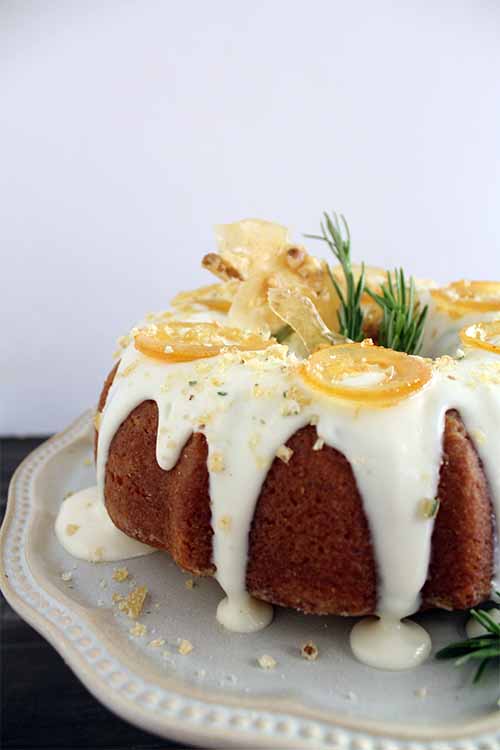
Now, I am not a very big fan of overly sweet desserts. You know those grocery store cakes with the insanely sweet frosting? Yeah no, not for me.
In fact, when I was younger, I would first take the cupcake liner off, wipe off the frosting, and only then would I begin to eat it! I still do that to this day.
I love desserts that just have a tinge of sweetness, like anything topped with lightly sweetened cream cheese frosting (I could eat it straight out of the bowl), a decadent dark chocolate lava cake, or a much simpler two ingredient cake recipe. Yes, those are my kind of desserts.
When a good cake comes around (without the powdered-sugar-doused frosting) then I am sure to take a good helping of that.
Maybe Cake’s Just Not for Everyone
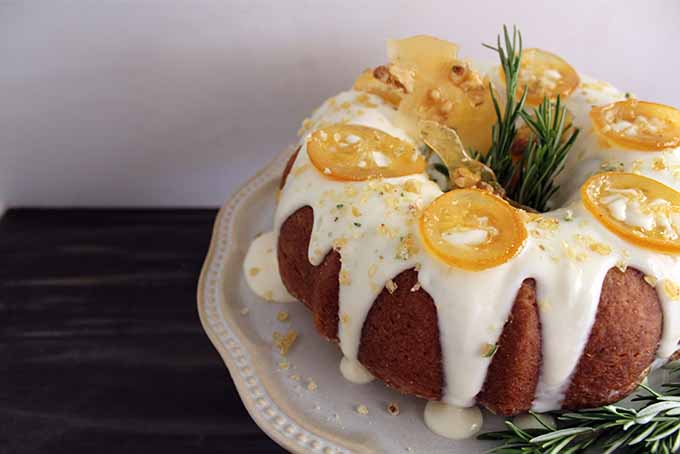
When I was younger, my mom would make the most beautiful layered and decorated cakes for special occasions; anything ranging from a Princess Ariel to a flower basket cake was found at the table, making everyone gaze at it in awe.
Lately, I have been really interested in going outside of my comfort zone (which has nothing to do with precise baking) and branching into baking and decorating beautiful confections, inspired by my mom’s talent. Don’t get me wrong, I love baking – but things more along the lines of cream puffs, pies, tarts, and lava cakes (yesss!).
Let me just tell you first that pastry chefs do not get enough praise, and credit, and absolute worship for the creations they are able to make out of flour, eggs, sugar, and frosting. I could go on and on talking about the many attempts I have made at baking and decorating cakes that have turned out looking like the Leaning Tower of Pisa, with frosting spilling out of the sides.
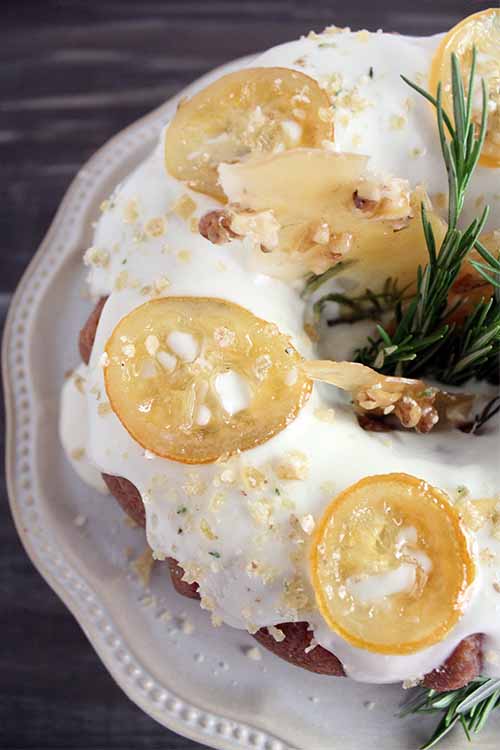
Of course, I just can’t use a simple box mix and frosting – I always like to do everything from scratch. But hey, this one took half the amount of effort and turned out 10 times better than any other cake I have made!
Decorating and baking beautiful confections is just not for everyone (meaning me)! I am one of those people who likes to be at the stove, adding ingredient after ingredient, tasting, cooking, and experimenting. You have a very slim chance of making a beautiful and complex baked dessert if you do any of this.
Follow the Rules (of Baking)
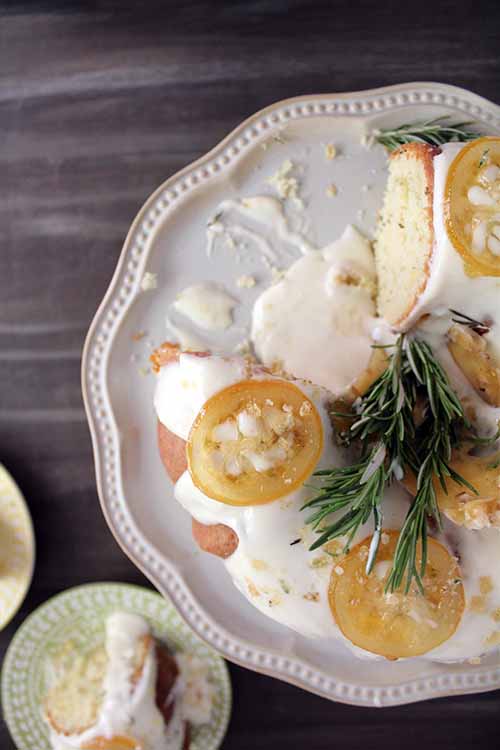
Over the years, I have learned one very important rule about baking: stick to the recipe!
I cannot tell you the countless number of times I decided to add a little more baking powder, or left the butter hard instead of softening it, and the entire dessert went “kerplop.” Or, the times I realized I was out of oil in the midst of baking (though thankfully, there are some smart saves and plenty of oil substitutions out there).
I am also really impatient when it comes to letting the cake cool, leveling it, chilling the frosting, and delicately piping the icing in between the layers – no, no, no, I cannot do this!
Then I discovered the magical creation that is bundt cakes. Oh bundt cakes, how I love thee.
Get Your Bundt in Gear
Here’s the thing: you won’t be able to find the words “leveling,” “piping,” or “trimming” in the Bundt Cake Dictionary. And that’s a good thing. Well, at least I think so.
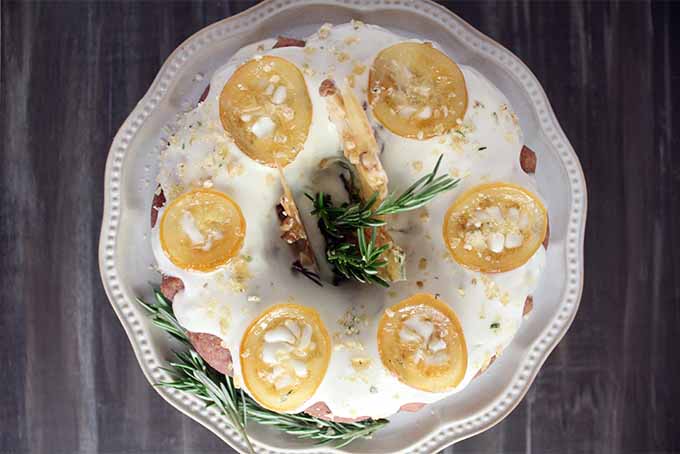
With regular cakes, you have to worry about making all the layers even and flat, and then cooling everything so your frosting doesn’t melt, and then crumb coating, and soon enough you (okay, again, maybe this is just me…) end up just rolling everything up into a ball instead.
Better to just avoid the whole thing, right?
This is the beauty of any dessert you decide to make in a bundt pan. It takes minimal effort to assemble the whole thing since it requires very little patience, skill, or focus when you’re flipping your cake over and pouring all of your delicious frosting on top.
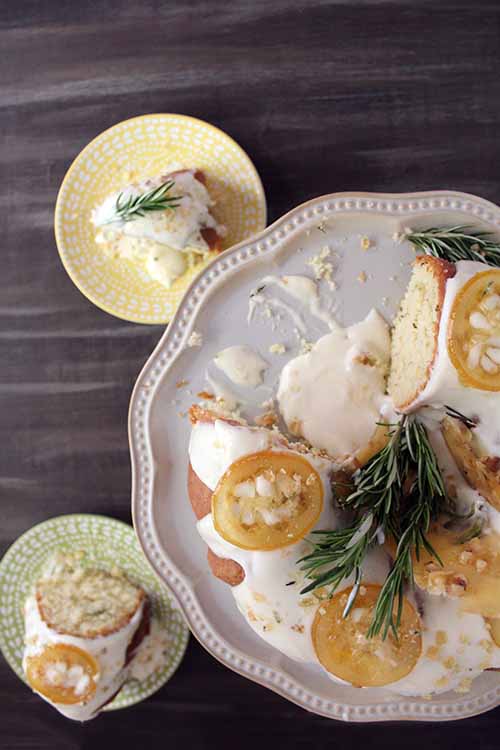
As I said, I am not a big fan of sweet desserts. But I am a big fan of experimenting with flavors, so I decided to switch up the classic lemon pound cake by adding a fresh herb with a more savory flavor – rosemary!
I first made this dessert about a year back, when I had a sudden urge to combine these flavors. To make things even better, I topped it with a goat cheese frosting – yeah, only someone like me would break out of the normal cream cheese frosting cycle.
During this time, when I had the ambitious motive to tackle layered cakes, I did not take into account the fact that my own creation probably wouldn’t turn out like something coming out of [enter well-known cake artist/pastry chef’s name here]’s kitchen.
My first attempt was a bit lopsided and way more dense than it should have been. But if we were judging it based on taste alone, it was amazing!
A Matter of Density
This is another positive when it comes to making bundt cakes – you don’t have that weight on your shoulders about executing a super light-as-air dessert (as is the case for other cakes, like angel food and those with multiple layers, like this delicious strawberry version) because these are supposed to be dense.
Of course, this doesn’t mean you should prepare yourself for cutting into a rock with some frosting spread on it. Do you get what I mean?
Most of the time, bundt cakes (also known as pound cakes) are very dense, but moist!
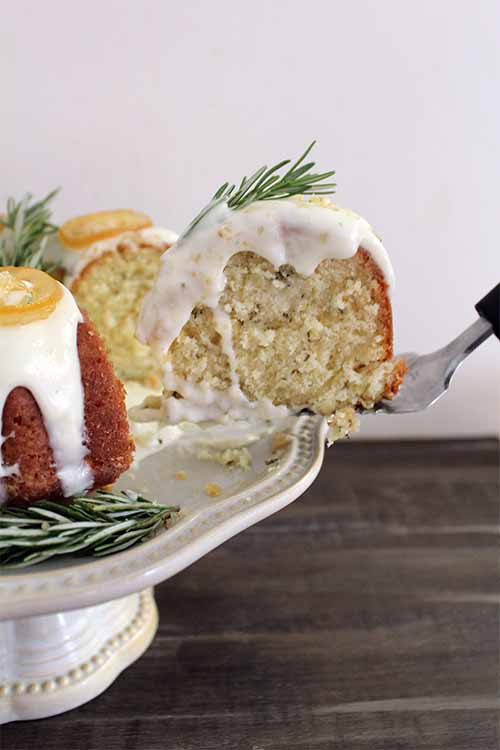
First, let’s clear up the terminology just a bit: a pound cake is not necessarily a bundt cake (as it can be baked in a bundt pan, or in other styles of bakeware) and a bundt cake is not necessarily a pound cake (since you can bake other types of batters in that pan as well). However, the terms are often used interchangeably.
A traditional pound cake was traditionally referred to as such because it was made with a pound of butter (4 sticks), a pound of flour (about 3 cups), and a pound of sugar (2 cups). My recipe below is made with less butter, so it’s not quite as dense as some might be. Nonetheless, I think it still qualifies.
Due to the amount of flour and butter in the batter, it’s much thicker than usual. It’s also highly recommended that this type of batter be baked in a bundt pan because that open tube in the middle heats the batter from the inside out, which is essential for a properly cooked cake.
In this case, a dense case is good! Since the shape of a bundt pan is really rather odd, you need a dense cake to be able to hold that form once it’s out of the pan.
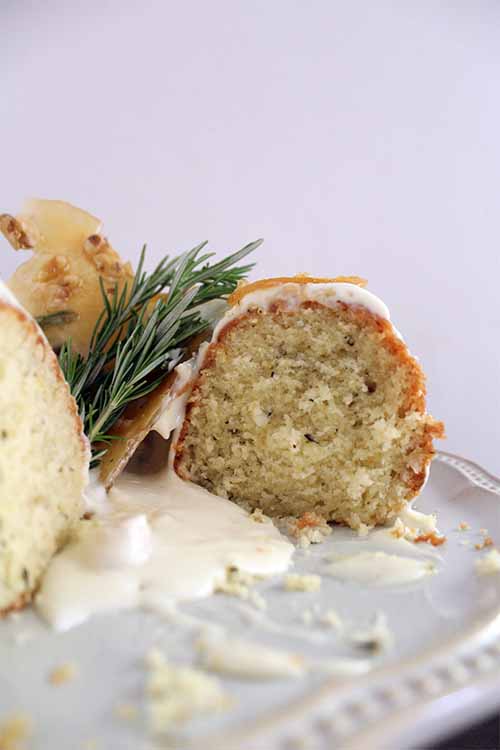
Another plus in terms of it being denser than normal is that it can hold tons (and I mean tons) of frosting! Ohhh, yes.
Again, don’t confuse density for a sign of a bad cake! Bundt cakes are a little dense, but they are so moist as well.
If you got bored reading this section then just remember this: many kinds of cake can be light and fluffy, but only bundt or pound cakes can get away with being dense.
Got it? Yeah? Great! Now I can start talking about my favorite part – the actual finished product.
Confection Perfection
Fast forward a year later to a perfected recipe that’s so different from what you would expect from a normal bundt cake!
The batter is infused with lots of lemon and rosemary, which perfumes the entire house when it hits the oven! After baking, it is soaked with a rosemary syrup, which enhances the flavors even more.
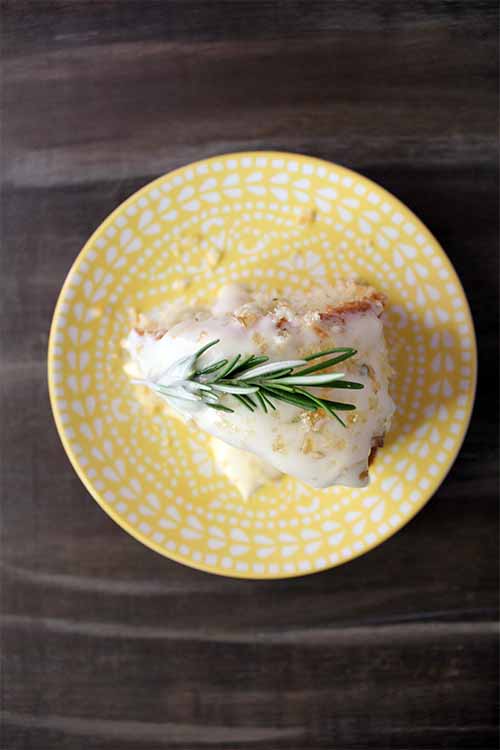
Keep in mind that you can apply this same rosemary syrup method to any lemon dessert! Feel free to experiment with different combinations to create new flavor pairings, with herb and fruit-infused syrups.
To start, try new herb and fruit combos. This is a great way to come up with an unexpected surprise for your guests at your next event!
The goat cheese frosting is honestly something you (okay, I…) could eat straight out of the bowl! It has the perfect amount of tanginess that compliments the sweetness of the cake.
The only thing left after soaking it with the glorious syrup is to flip it onto a serving platter and pour that delicious frosting all over it. Make it pretty with some sweet edible garnishes while you’re at it – and don’t forget to take some pictures before you dig in!
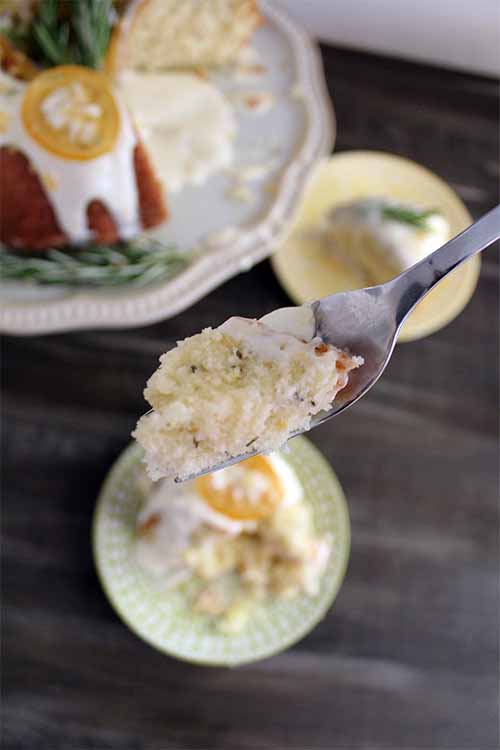
The cake is nice and firm, so it holds its shape perfectly when you cut into it. When you take your first bite, the crumbs just melt in your mouth with an unexpected airiness from the batter, which is so different from most bundt cakes. The rosemary syrup makes everything so moist, and the frosting is the perfect finishing touch to a great dessert.
Tips & Substitutions
Adjusting the Cake’s Sweetness
I do not like very sweet desserts, so I always put less sugar than is called for. However, you need to be careful with extreme substitutions.
Do not put in only 1/4 cup of sugar if the recipe calls for 2 cups – this can change the texture, cooking time, and color of your cake completely. I always use around 75% of the sugar called for in the recipe and it turns out great!
This cake has some savory and tart notes, so if you want to ramp up the sweetness instead, add an extra 1/4 cup of sugar to the batter.

Out of Buttermilk?
For some reason, I never have buttermilk on hand. But there is a super quick fix for that!
I measure out 1 cup of milk, removing 1 tablespoon from the cup (basically, you will have 3/4 cup and 3 tablespoons of milk), and mix with a tablespoon of lemon juice or vinegar. I used lemon juice this time because, well, it is a lemon dessert.
Keep in mind that you want to add a vinegar with a more neutral taste and color, such as apple cider or white vinegar. Do not add balsamic, red wine vinegar, or any other type with a dark color or powerful flavor.
Let the mixture sit for 10 minutes and you should notice it curdling a bit – this means it is working! It makes the perfect substitute for buttermilk.
Rosemary Syrup
Making this shortly before you’re ready to use it is preferable, since you want both the syrup and the cake to still be warm. This will help the cake to absorb the syrup well.
If you’ll be making this syrup ahead of time, remove the rosemary sprigs before storing, and reheat until warm before using. Set aside to cool until it’s just warm to the touch, and then it’s ready to go.
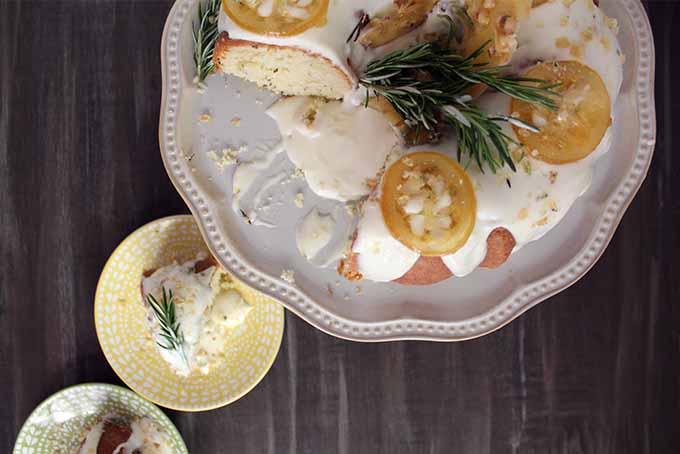
Not into the Goat?
If you are not a big goat cheese fan or do not have access to a soft chevre, you can easily substitute cream cheese. To make up for the lack of tanginess, add an extra teaspoon of lemon zest or tablespoon of lemon juice, keeping an eye on the consistency.
Check the Salt
Also for the frosting, start with the stated amount of salt. If you’ve made any substitutions like adding more sugar, you might need a bit more. Add in a pinch of salt at time, and continue tasting to see if more is needed.
Thick or Thin Icing?
If you would like to make your frosting thicker (to pipe onto the cake, for example), add more confectioner’s sugar until the desired consistency is reached (but note that it will be sweeter!)
I recommend mixing some cornstarch into your sugar if you want it to be thicker. First, mix your powdered sugar with cornstarch in a ratio of 3:1. For example if you were using 3 cups of powdered sugar, you would add 1 cup of cornstarch. Then follow the recipe as stated.
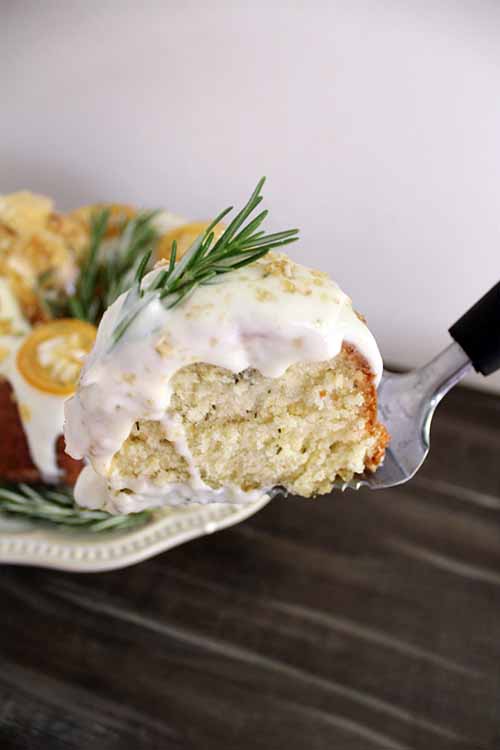
Remember not to add too much cornstarch or you will mask the flavor of the goat cheese and the resulting mixture will taste chalky. When you’re adding a thickener like cornstarch, the texture may also turn out very stretchy.
The maximum amount of cornstarch I recommend adding to this recipe (if any) is 1/2 cup. If you simply want your frosting to be sweeter with the same consistency, add more powdered sugar and milk. For every 1/4 cup of sugar you add, add a tablespoon of milk as well.
Decorating Your Creation – Candied Citrus, Herbs, Homemade Brittle Candy & Edible Flowers
Though a simple icing is pretty enough on its own, sometimes it’s fun to spice things up a little. Edible decorations that fit with the theme and flavor pairings of the recipe make excellent additions.
First, I garnished mine with sprigs of fresh rosemary, and candied lemon slices . Then I topped it all off with pieces of homemade brittle candy.
Making your own candy brittle to top your creation is pretty simple as well.
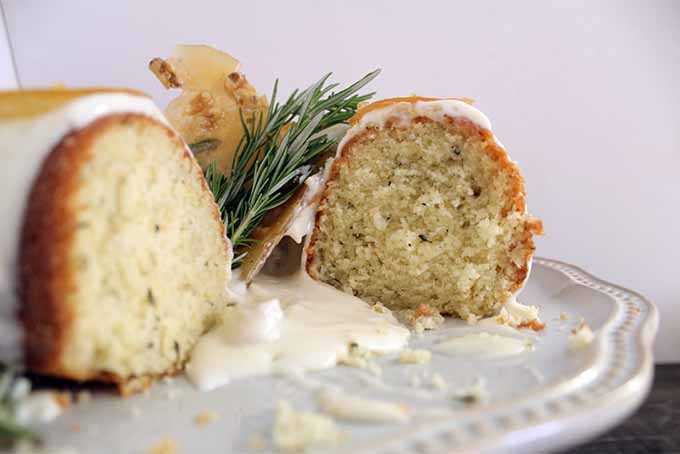
First, combine equal parts water and sugar (I used 1 cup each). Bring to a boil, then simmer on low heat until the color turns a deep golden brown, around 20 to 30 minutes.
Pour onto a baking sheet lined with a Silpat nonstick silicone liner or parchment paper, and sprinkle with whatever you would like! I used chopped walnuts and rosemary sprigs. Make sure everything is ready to go before you put your sugar on the stove, because you need to do this quickly.
Let cool for about 15 minutes, and then hit it a few times with a rolling pin or heavy spoon. Now you’re ready to take any dessert presentation to the next level!
Edible flowers would also be lovely on this cake.
The Recipe
- 3 cups all purpose flour plus more for pan
- 1/2 tsp baking soda
- 1/2 tsp baking powder
- 1/2 tsp salt
- 1 1/2 tbsp freshly chopped rosemary (3-4 sprigs)
- 1 1/2 tbsp grated lemon zest from 2-3 large lemons
- 1 cup softened unsalted butter plus more for pan
- 2 cups granulated Sugar
- 1 tsp vanilla
- 3 large eggs
- 1 cup buttermilk
- 2 tbsp fresh lemon juice
- 1/3 cup water
- 1/3 cup granulated Sugar
- 3 whole sprigs of rosemary
- 8 oz. room temperature goat cheese
- 4 oz. room temperature cream cheese
- 1/2 cup room temperature butter
- 1/4 tsp vanilla
- 1/4 tsp salt
- 1/2 cup confectioners’ sugar
- 2 tbsp milk,
- 1 tsp lemon zest
- Candied lemons (optional)
- Fresh rosemary sprigs optional
- Brittle optional
- Preheat the oven to 325°F with your oven rack in the middle position. Liberally grease a 10-inch bundt pan with softened butter, making sure you get all the nooks and crannies. Add in about a cup of flour and shake the pan, coating all the butter. Tap out any excess flour.
- In a large bowl, whisk together the flour, baking soda, baking powder, salt, rosemary, and lemon zest. Set aside.
- In a stand mixer (or using a hand mixer and another large bowl), cream the butter, sugar, and vanilla on medium speed until paler in color and fluffy, around 3 minutes. Scrape down the sides of the bowl and mix in the eggs, adding them one at a time. Scrape the sides of the bowl again.
- On low speed, add in a third of the flour mixture and mix, then add half of the buttermilk mixture and mix some more. Next, add half of the remaining flour, mix, the rest of your milk, mix, and finally the rest of your flour. You want to start and end by mixing in flour because this insures the ingredients don’t slosh around and that everything is incorporated well. Never add all of the flour or milk at once, since this can lead to overmixing and a very dense batter!
- Mix in the lemon juice, also on low speed.
- Scrape down the sides of the bowl and pour into your prepared bundt pan. Tap a few times on the counter, then smooth out the top of the batter with a spatula. Give it a few more taps, then bake for 60-65 minutes until the top is golden brown and a toothpick comes out clean.
- While your cake is baking, you can prepare the syrup and the frosting (directions below).
- Remove your cake from the oven and let it rest on a wire rack. Brush the top of the cake with the rosemary syrup (about a third of the mixture) and let it cool for 10-15 minutes. Transfer your cake onto a serving platter (rounded side up) and brush the rest of the syrup on top. Let cool for another 20-30 minutes.
- Combine the water, sugar, and rosemary in a small pot. Stir. Let the mixture come to a boil, then remove from heat. Keep the sprigs in the syrup while it is cooling, and brush it onto the cake when warm to the touch.
- In a stand mixer (or using a hand mixer), cream the goat cheese, cream cheese, butter, vanilla, and salt on medium speed until well incorporated and fluffy, about 2-3 minutes. Scrape down the sides of the bowl.
- With your mixer turned off, add in half of the powdered sugar, and mix on low speed until well incorporated. Add in the rest of the sugar and mix on low speed until combined. Scrape down the sides of your bowl.
- Finally, mix in your milk and lemon zest. The frosting should be the consistency of regular yogurt (not Greek yogurt).
- Give your frosting a few stirs before pouring, spooning, or piping it on your cake. Decorate your cake with some candied lemon slices, fresh rosemary sprigs, brittle, and so on. Let your imagination go wild here! Serve at room temperature.
- If making ahead, do not leave the cake on your kitchen counter (unless you live in a colder climate) as the goat cheese in the frosting may start to taste sour. Store in your fridge until 30 minutes before serving. For best results, this cake should be served immediately.
Recipe for cake batter adapted from Once Upon a Chef's Lemon Buttermilk Pound Cake.
I really hope you guys give this a try, and take a different direction with your classic lemon cake next time!
Did you end up with a cake that doesn’t rise? We’ve got tips for that.
How did this recipe work for you? What’s your favorite variation to make at home? Oh I can think of the endless possibilities now – lemon and lavender, orange and thyme, lime and mint! Let us know in the comments! And don’t forget to check out Rachel’s site!
For more lovely and easy bundt cakes, bake any of our favorites:
Photos by Rachel’s Eats.
About Rachel
Rachel is a high school student in the Bay Area who has, for the most part, an average teenage life. Loaded with all of the usual things like academics, sports, and clubs, Rachel also has a unique passion for cooking. Since she was a toddler, Rachel has always been interested in the culinary world. She first started cooking at the age of eight, and has worked her way up from simple scrambled eggs to more intricate and complicated items like croquembouche (i.e. a French cream puff tower). At the beginning of high school, Rachel started her very own food blog and YouTube channel called Rachel’s Eats, where she shares her passion and unique recipes with readers and viewers online. Rachel has always been a foodie, and anything related to cooking and food excites her more than anything else. When she’s not in the kitchen, you can find Rachel playing tennis or the piano, painting, or watching Modern Family. Her greatest goal in life is to pursue her passion in the culinary industry, and hopefully own her own business someday where she can continue to share her food with the world.



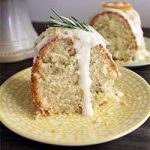

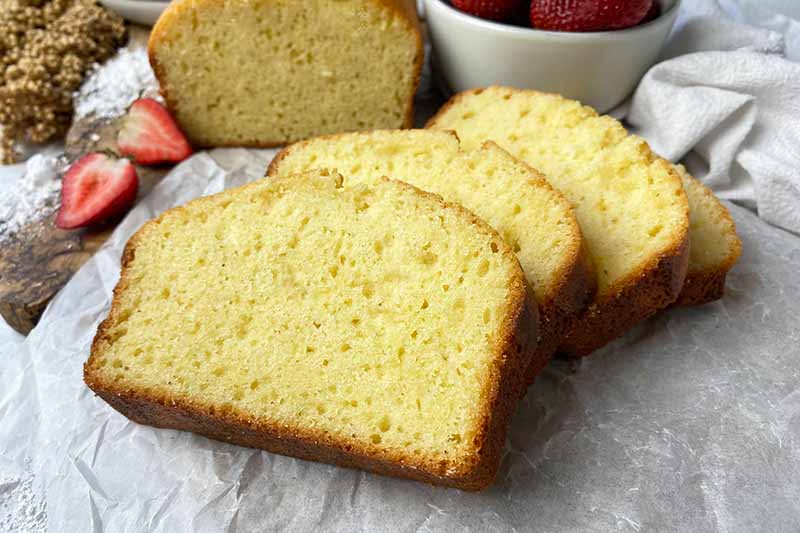
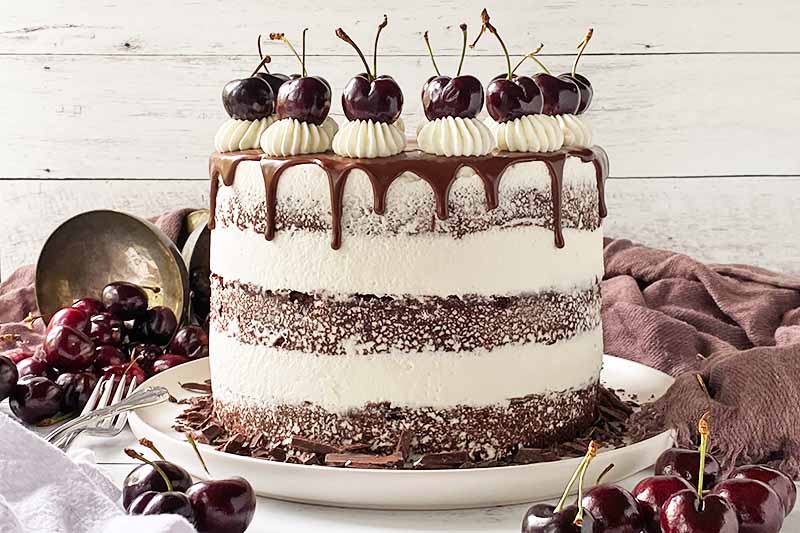
Well I am not sure that if you just told me the name of the dish I would necessarily understand what is going on here, but I have to say that it looks delicious. More than that, though, I think that it looks like a lot of fun to make. These are really traditionally might not go together, so I always have more fun with recipe that are new and not your typical old thing. Thanks for sharing.
This is a dessert by name, I was a little turned off by, but by pictures and description, I became more and more intrigued by. Rachel, you are definitely going places, keep up the great work, and yes, I checked out the blog…..loved the recipes!
Ok, I haven’t made this cake yet, but what really drew me to this recipe is the Goat Cheese Icing. I love cream cheese frosting. Honestly, it’s about the only frosting I will eat. However, just like with anything, I get bored with it sometimes since most of my cakes are topped with it. I definitely have to make this Goat cheese icing version. It got me to thinking about using other softer cheeses in the same way, like Brie or Marscapone. I bet I could make something tasty and similar, but different enough to give me some variety!
Oh who doesn’t love cream cheese frosting? I have never had goat cheese icing before but I’m intrigued and eager to try out this recipe. I love experimenting with new flavors and textures and making this cake will certainly allow me to do that.